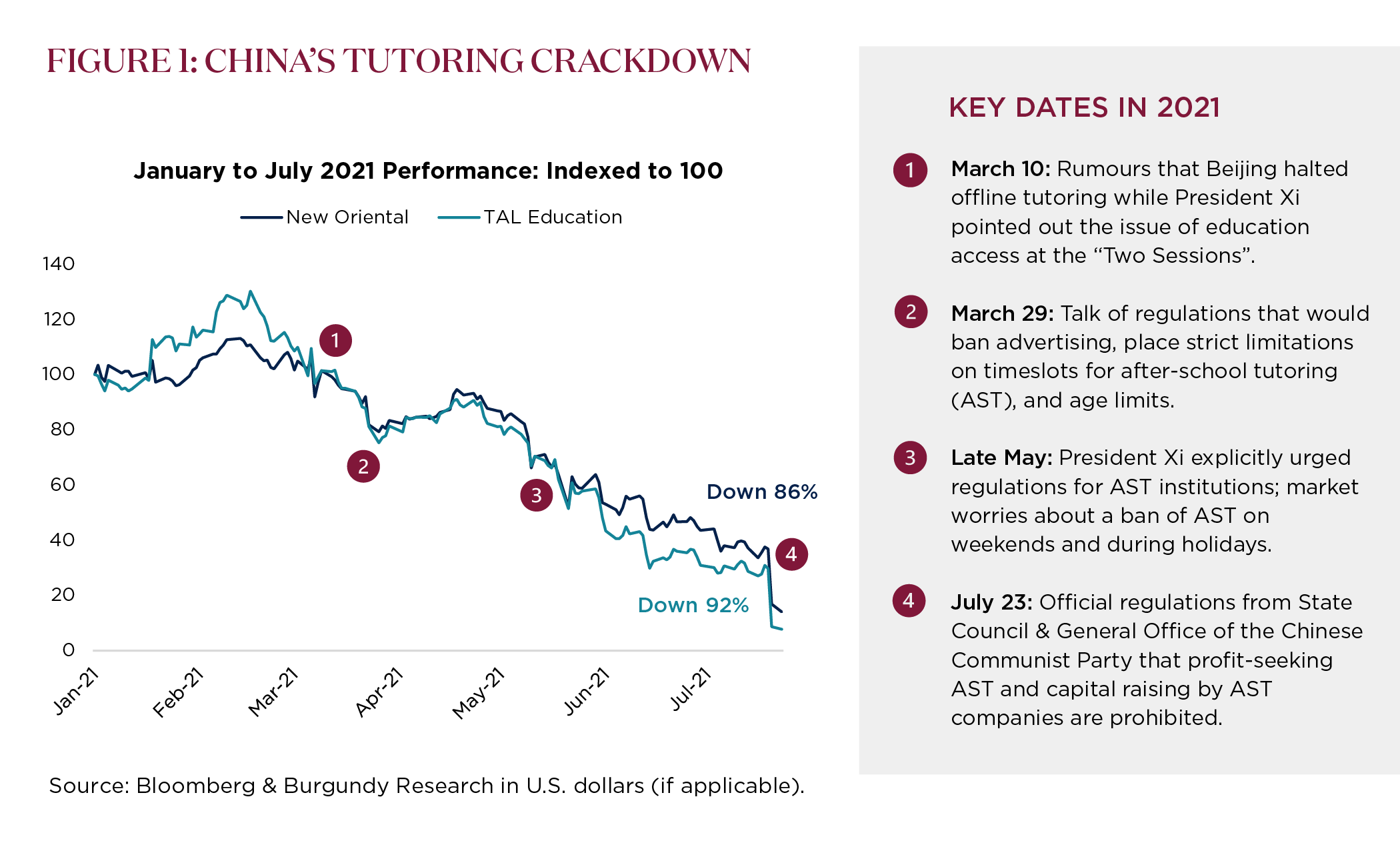In our latest Journal, Investment Analyst David Hao draws parallels between Korea and China and considers how comparative research allows for more informed investment decisions.
Key Points:
- Studying Korea can be used to assess the path forward for China.
- Understanding how a business serves all stakeholders helps to determine attractive financials vs. unsustainable earnings.
- Society and institutions experience far bigger changes in the emerging markets than in the developed markets, creating both risks and opportunities
At Burgundy, our emerging markets team covers a wide range of countries, and researching one region often helps us inform our understanding of another. After visiting Korea for the first time earlier this year, I couldn’t help but draw parallels with China. Since Korea’s development pathway has been, and continues to be, heavily studied by Chinese policymakers, researching Korea is deeply revealing. Through the exploration of three separate vignettes, I will share how we can use this research to assess the path forward for China.
Vignette #1: “Clear” Water
In downtown Seoul, an 11-kilometre-long stream called Cheonggyecheon runs through the city centre. This redeveloped stream has an eventful past, reflecting the country’s decades of rapid economic development. Since the 1960s, rapid industrialization transformed the stream into a badly polluted ditch, turning its name, which translates to “clear water stream,” into a paradoxical misnomer. Eventually, the stream was paved over. Years after that, an elevated highway was built. In 2003, Cheonggyecheon was part of a large and elaborate restoration project imposed by the municipal government. The intent was to better withstand floods and to improve the city’s irrigation infrastructure. Today, the restored stream is a picturesque and popular destination among tourists and locals alike.
To me, Cheonggyecheon is a symbol of urban progress and development that I doubt many (foreigners and Koreans alike) could have predicted 30 years ago. Since we often see things through our North American vantage point, we may forget how important resource management (in this case, water) is in parts of the world where resources are not as abundant.
In China, decades of rapid industrialization have resulted in significant environmental pollution as well. To combat this, since the mid-2010s, the country has taken significant steps to control pollution and protect the environment. The Yangtze Protection Act of 2020 is one of these efforts, a legislation to help improve water management for Asia’s longest river. As a result, we’ve identified several good businesses that benefit from these environmental protection policies and have even placed them on our Dream Team. Conversely, there are several industries/companies that have suffered from rising compliance costs due to increasingly stringent environmental regulations or have had to shut down entirely. The environmental protection policy maturation process is a double-edged sword, and we intend to be on the right side of it.
Dream Team Companies: These companies embody the business, financial, and management characteristics that Burgundy deems high quality, but their current market prices do not offer enough of a margin of safety to warrant investing at this time.
As we deepen our understanding of investing in China, the environment is among many areas of focus. In the context of resource scarcity in China, critical water infrastructure, energy infrastructure (i.e., wind/solar, hydrogen, and energy storage value chains), and agricultural infrastructure are going to be increasingly important. We’ve spent considerable efforts to broaden our understanding of these sectors and have identified multiple admirable businesses that we’ve also placed on our Dream Team.
Furthermore, the quality of infrastructure in a particular region helps us determine the sustainability of our investments and the downside risks. These topics are especially important in the emerging markets, where institutions, societies, and businesses are often less engrained and still evolving, therefore needing our additional attention. Understanding how a business interacts with all stakeholders is paramount to delineating between attractive financials vs. unsustainable earnings that may be regulated away as society matures.
Vignette #2: The Involuted Rat Race
When assessing long-term business prospects in the emerging markets, we consider environmental, social, and governance (ESG) risks and opportunities to be critical to our research, and the ESG lessons we learned in Korea have helped us avoid a hidden danger in China.
Visit our 2022 ESG Report, where we further highlight the social risk involved in China’s after-school tutoring.
Like many cultures, Korean culture values education, and the competitive dynamics of the CSAT (Korea’s standardized testing for university entrance) are intensive. This parallels the situation in China with the Gaokao, the university entrance exam equivalent. Due to rising incomes and the desire for better education, parents in China have begun to invest significant amounts of their hard-earned dollars to after-school tutoring, much like Korean parents did. In some Chinese consumer panels, we observed that after-school tutoring represented up to 20% of a family’s disposable income. This resulted in significant growth in the after-school tutoring industry and produced attractive looking financial statements. After years of growth and profitability, the Chinese government intervened, and the industry turned into a non-profit in short order with stocks imploding thereafter. Investors in these businesses experienced what it felt like to be a turkey on Thanksgiving.
Revisit the 2009 View from Burgundy titled The Year of the Turkey. This piece looks back at what Burgundy learned in 2008 about risk and uncertainty in the markets and explores how our process is designed to protect us from the dangers of consensus.
Despite statistically attractive financials, we chose to sidestep the Chinese after-school tutoring companies entirely, believing the cost burden on parents and the psychological pressures on children were unsustainably benefitting investors. By doing so, we were able to avoid the consequences of the tutoring crackdown that followed. (This is highlighted in Figure 1, which covers the 2021 regulatory impact of the two most prominent after-school tutoring companies in China.) While this might have looked “smart” in hindsight, this decision was largely informed by our experiences observing the similar episode of Korean government intervention in after-school tutoring a decade prior. This reinforced our belief that profitability should not come at the expense of stakeholders (and certainly not all other stakeholders) to benefit shareholders, and our observations in Korea helped us avoid a hidden danger in China.

Vignette #3: Big vs. Little Giants
The greater Seoul metropolitan area’s vibrant business scene is palpable, and so is Korea’s economic dynamism. Along with the household-name Chaebols (which are large conglomerates like Samsung Group, a Burgundy holding), we also met with several smaller enterprises during our most recent visit to Korea. We noticed that these smaller enterprises operate in niche markets in which they have dominant market positions and competitive advantages. These management teams are keenly aware of how hard they must work to retain that edge by innovating and staying ahead of the competition. During multiple conversations, I sensed the national pride coming from the management teams as they shared how their company’s products were poised for dominance across the world. While household names like Samsung, LG, and SK Group control a significant portion of Korea’s gross domestic product, there are also many smaller, lesser-known enterprises. At Burgundy, although we consider the liquidity of our investments, we do not discriminate based on the absolute size of businesses, only the quality of the business and the possibilities of strong prospective risk-adjusted returns. Specifically, a smaller company with a dominant market positioning in its niche market could be a better investment than a larger company in a less favourable competitive landscape. As we sift through these smaller businesses, we’ve also found Dream Team candidates and portfolio holdings among them.
So, how does this relate back to China? Not surprisingly, Chinese policymakers have studied the development history of Korea and devised similar plans. The nomenclature of “specialized, refined, peculiar, and innovative little giants” first appeared in official policy documents in 2011 and was brought to the forefront of policy priority as a result of the need for industrial upgrade, the economic policy priority of moving away from low value-added manufacturing (apparel, toys, etc.) and into higher value-added manufacturing (motors, precision machinery, industrial robots, etc.). Over time, as businesses become more research-and-development intensive and learn to build more sophisticated capabilities, the best managed and well-positioned companies will create profitable solutions for customers, dominate their chosen niches (and/or successfully grow into new attractive markets), and expand their competitive advantages. These are the companies we are looking for. As of September 2022, the Ministry of Industry and Information in China has identified some 9,000 of these “little giants.” While not all will be successful, and certainly not all will meet our quality criteria, our team will continue to sift through these innovative businesses, assessing for quality and looking for strong management teams to capitalize on the next phase of China’s economic development. As a result, we are excited about the prospects of this upgrading spanning various sectors and industries. Applying our observations in Korea can help us identify investments in similarly small but dominant businesses in China.
“…our team will continue to sift through these innovative businesses, assessing for quality and looking for strong management teams to capitalize on the next phase of China’s economic development.”
Final Thoughts
At Burgundy, our investment team combines on-the-ground research with an open exchange of ideas among our regional teams on a single floor in our main office. Research trips allow us to reach a deeper understanding of these businesses, customers, and societies beyond what we read and see in the news, and discussions with our colleagues afterwards further broaden our understanding and theirs.
These three vignettes help shed light on the areas where we need to remain alert and are just a few examples of how studying Korea can be used to analogize the path forward for China. Our research in Korea offers a lens to evaluate the investment implications of rapid industrialization, ESG risks and opportunities, as well as the impact of innovative enterprises (big or small) on economic development. And our lessons in Korea help us draw parallels to arrive at a more nuanced understanding of China, while acknowledging the risks and opportunities that come with investing in a developing country where society and institutions experience much larger changes.
By working our process and thinking like owners, we can sidestep landmines and make good investment decisions to generate strong long-term investment results.
This communication does not consider unique objectives, constraints, or financial needs. It is for information purposes only and is not intended to offer investment, legal, accounting, or tax advice; provide recommendations or offers of solicitation; serve recruitment purposes; and/or serve marketing purposes. Burgundy assumes no obligation to revise or update any information to reflect new events or circumstances, although content may be updated from time to time without notice. Any numerical references are approximations only. Forward looking statements are based on historical events and trends and may differ from actual results. Content and links provided in this piece include proprietary information of Burgundy Asset Management Ltd. This content is not to be distributed without consent from Burgundy, and this is not intended as an offer to invest in any investment strategy offered by Burgundy. Viewers are advised that investments are not guaranteed, values change frequently, and past performance may not be repeated. Investing in foreign markets may involve certain risks relating to interest rates, currency exchange rates, and economic and political conditions. Because Burgundy’s portfolios make concentrated investments in a limited number of companies, a change in one security’s value may have a more significant effect on the portfolio’s value. Characteristics described are also for illustrative purposes only and may exclude companies in the financial sector or with negative earnings as well as any outliers, as determined by Burgundy. Investors should seek financial investment advice regarding the appropriateness of investing in specific markets, specific securities or financial instruments before implementing any investment strategies discussed. Under no circumstances does any commentary provided suggest that you should time the market in any way. For more information, please see Burgundy Asset Management – Legal.
Investing in foreign securities typically involves more risks than investing in Canadian and U.S. securities, and includes risks including but not limited to those associated with political/economic developments, volatility, trading practices, information availability and accessibility, market limitations, and currency considerations. Investing in Greater China and its surrounding regions, however, involves an even greater degree of heightened, specific risks which may result from but are not limited to the following: China’s dependence on exports and international trade, increasing competition, imposition of tariffs and other financial limitations, volatility, government control, regulatory risk and a heightened regulatory regime, political/economic relationships, trading suspensions/government interventions and decisions, and/or the risk of nationalization or expropriation of assets.

